少儿英语-DEMO课件
- 格式:ppt
- 大小:7.00 MB
- 文档页数:31
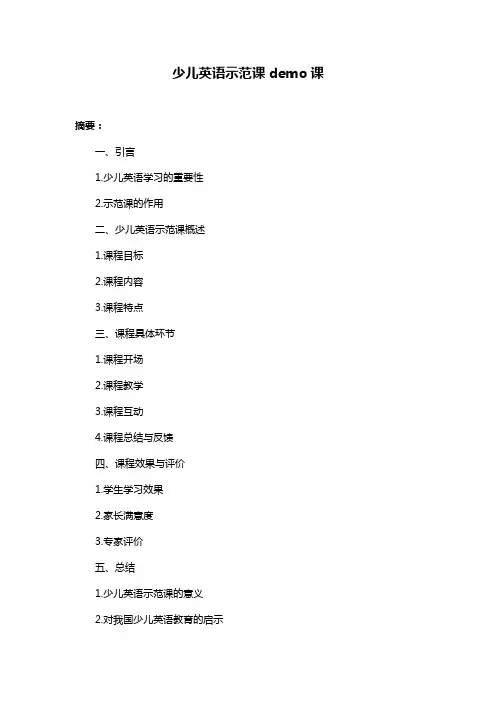
少儿英语示范课demo课摘要:一、引言1.少儿英语学习的重要性2.示范课的作用二、少儿英语示范课概述1.课程目标2.课程内容3.课程特点三、课程具体环节1.课程开场2.课程教学3.课程互动4.课程总结与反馈四、课程效果与评价1.学生学习效果2.家长满意度3.专家评价五、总结1.少儿英语示范课的意义2.对我国少儿英语教育的启示正文:一、引言随着全球化的加速推进,英语作为国际通用语言,在我国受到了前所未有的重视。
特别是对于少儿阶段,英语学习不仅能提高孩子们的综合素质,还能为他们日后的发展打下坚实基础。
为了更好地推广少儿英语教育,许多学校和教育机构纷纷开设了少儿英语示范课,以展示英语教学的魅力和效果。
二、少儿英语示范课概述1.课程目标:少儿英语示范课旨在激发孩子们对英语的兴趣,培养他们良好的英语学习习惯,提高听说读写综合能力。
2.课程内容:课程内容涵盖了英语基础知识、简单日常对话、英语儿歌、英语故事等方面,旨在让孩子们在轻松愉快的氛围中学习英语。
3.课程特点:示范课注重培养孩子们的英语思维,采用互动式教学,让孩子们在情景模拟、游戏、角色扮演等多种活动中学习英语。
三、课程具体环节1.课程开场:教师通过英语自我介绍和简单的英语游戏,拉近与孩子们的距离,调动孩子们的学习积极性。
2.课程教学:教师以生动有趣的英语故事或情景对话为主线,引导孩子们积极参与,鼓励他们勇敢地用英语表达。
3.课程互动:教师组织孩子们进行小组讨论、角色扮演等互动活动,让孩子们在实际应用中提高英语能力。
4.课程总结与反馈:教师对课程进行总结,对孩子们的表现在家长会上给予反馈,以便家长了解孩子的学习情况。
四、课程效果与评价1.学生学习效果:通过参加少儿英语示范课,孩子们在听说读写各方面都取得了明显的进步,学习兴趣和自信心得到了极大的提高。
2.家长满意度:家长们对课程给予了高度评价,认为示范课既培养了孩子的英语兴趣,又提高了他们的英语能力。
3.专家评价:教育专家表示,少儿英语示范课的成功举办,为我国少儿英语教育提供了有益的借鉴和启示,值得推广和借鉴。
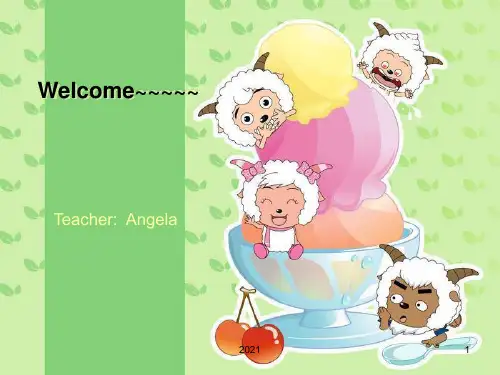
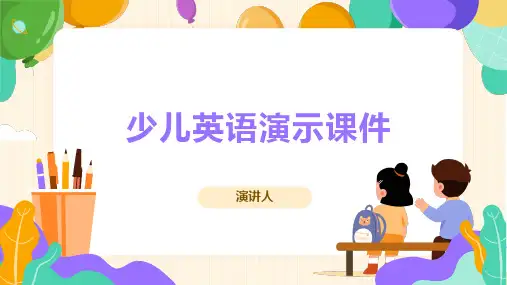
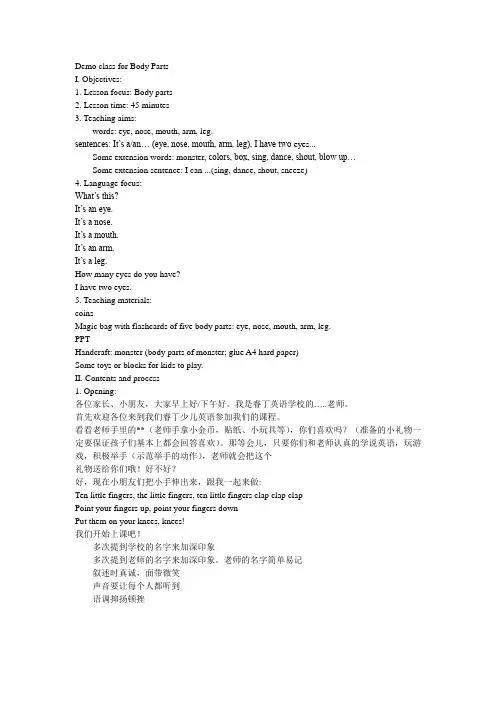


剑桥国际少儿英语全套教学课件目录•Introduction to Cambridge International Children's English •Training of Listening and Speaking Skills•Improving reading and writing skills •Consolidating vocabulary and grammar knowledge•Cultural background and cultivationof cross cultural communicationskills•Establishment of course evaluation 目录and feedback mechanism01 Introduction to Cambridge International Children's EnglishTeaching philosophy and objectives010405060302Textbook System and CharacteristicsApplicable objects and advantages02 Training of Listening and Speaking SkillsListening training strategiesPredictive listening01Selective listening02Intensive listening03Oral expression skillsVocabulary developmentSentence structureFluent deliveryScenario dialogue exampleRole playsInformation gap activitiesConversational exchanges03Improving reading and writing skillsEnhance students to predict what they will read about based on the title, headings, and any accompanying imagesPredicting contentTeach students how to quickly read through a text to get the gift of the information (skimming) and how to search forspecific details (scanning)Skimming and scanningHelp students build their vocabulary by teaching them strategies to see the meaning of unknown words from context clubsUnderstandin g vocabularyGuide students to read between the lines and make references based on what they have readInferring informationReading comprehension methodsWriting Skills GuideRecommendation and comments on model essays04 Consolidating vocabulary and grammar knowledge输入标题02010403Vocabulary memory methods0102TensesNounsAdjectives …PositionsSentence structure030405Summary of grammar pointsPractice question bank and answers Multiple choice questions Gap fill exercisesTranslation exercises Writing prompts05Cultural background and cultivation of cross cultural communication skillsIntroduction to English speaking Counties and CulturesOverview of major English speaking countriesCustoms and conditionsValues and ways of thinkingCross border communication etiquette guidanceBasic communication etiquetteand farewellsDining etiquetteand wine cultureBusiness etiquetteRole playing activities Cultural exchangeactivitiesPracticalapplication tasksDesign and organization of practical activities06 Establishment of course evaluation and feedback mechanismStudent self-assessment report templateDesign of self-assessment questionsincluding speaking, listening, reading, writing, and other aspects tocomprehensively evaluate students' English proficiencyRegular submission of self-assessment reportsrequesting students to submit self-assessment reports on a regular basis tohelp teachers understand students' learning progress and differencesGuidance and feedback on self-assessmentteachers provide guidance and feedback on students' self-assessment reportsto help students improve their learning methods and strategiesConstruction of Teacher Evaluation Index System Establishment of evaluation criteriaCollection and analysis of evaluation dataFeedback and improvement measuresParental feedback channel settingsEstablishment of parent feedback channelsCollection and handling of parental feedbackFeedback and communication with parentsTHANKS 感谢观看。

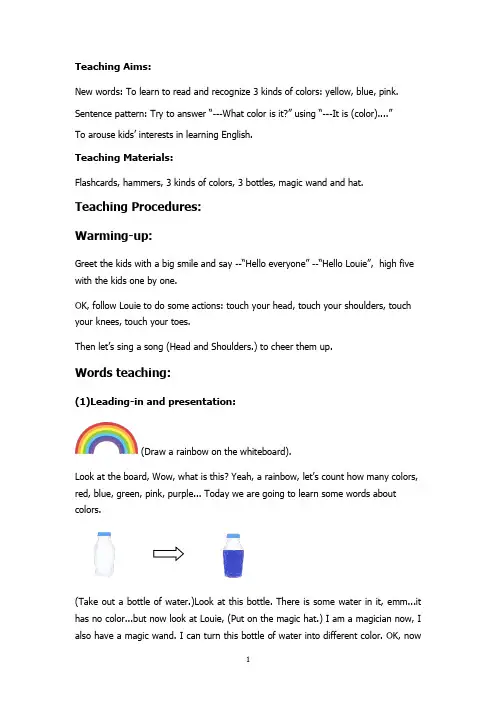
Teaching Aims:New words: To learn to read and recognize 3 kinds of colors: yellow, blue, pink. Sentence pattern: Try to answer “---What color is it?” using “---It is (color)....”To arouse kids’ interests in learning English.Teaching Materials:Flashcards, hammers, 3 kinds of colors, 3 bottles, magic wand and hat. Teaching Procedures:Warming-up:Greet the kids with a big smile and say --“Hello everyone” --“Hello Louie”, high five with the kids one by one.OK, follow Louie to do some actions: touch your head,touch your shoulders, touch your knees, touch your toes.Then let’s sing a song (Head and Shoulders.) to cheer them up.Words teaching:(1)Leading-in and presentation:(Draw a rainbow on the whiteboard).Look at the board, Wow, what is this? Yeah, a rainbow, let’s count how many colors, red, blue, green, pink, purple... Today we are going to learn some words about colors.(Take out a bottle of water.)Look at this bottle. There is some water in it, emm...it has no color...but now look at Louie, (Put on the magic hat.) I am a magician now, I also have a magic wand. I can turn this bottle of water into different color. OK, nowlook carefully, balabala....(Use the wand to point at the bottle.) It has magic now. (Invite a kid to come to the front, let him or her shake the bottle.) Now let’s say “shake, shake, shake.” together.(The color of the water becomes blue.) Wow, look, it changes, it is blue! Now follow me, let’s read it 3 times: blue, blue, blue. Now let’s play a game(Do a demo first.): high and low voice.How amazing!OK, How about this bottle of water?Who wants to be the magician? (Ask a kid to come to the front. Let him or her say “balabala...”, and use the magic wand to point to the bottle.) Then have him or her shake the bottle, at the same time have all the kids say “shake, shake, shake.” Wow, look, it changes, it is yellow! Now follow me, let’s read it 3 times: yellow, yellow, yellow. Now let’s play a game(Do a demo first.): Tap the flashcard and say it out.Use the same way to introduce “pink”. Then let’s read it 3 times: pink, pink, pink. Now le t’s play a game(Do a demo first.): Jump and use your head to touch the flashcard.……(Remember to review the previous words after teaching them the new one.)(2)Practice:OK, let’s put the flashcards on the floor, let’s have a quick review of the 4 words. Then let’s play:Game1(Do a demo first.): Jump to the right flashcard according to what the teacher says.Game 2(Do a demo first.):Magic box: Kids take out one kind of color from the magic box randomly and try to say it out.(3)Production:Quick response(Do a demo first.): Teacher show the flashcards to the kids quickly, have the kids recognize the word and say it out as quickly as they can.Sentence teaching:(1)Presentation:(Teacher prepares some objects of the 3 colors that we teach them today.) Find out the blue things one by one and at the same time say “It is blue.” together. Have the kids know we are talking about the color of the things. Have them repeat.Then find out the yellow things one by one and at the same time say “It is yellow.” together. Have them repeat.The same way to introduce the sentence: “It is pink.” Repeat.(2)Practice:Magic box(Do a demo first.): Pick up a thing from the magic box and quickly say “It is.... according to what color the thing is.(3)Production:Game:(Do a demo first.)Find certain things in certain color according to what the teacher says.Wrapping-up:Teacher quickly shows a flashcard randomly and have the kids say the word out together, then show the color together with the objects of that color and say the sentence: “It is (color).....”。